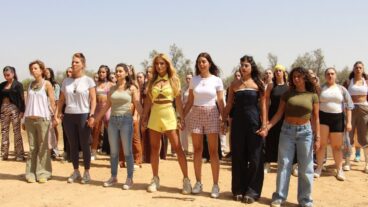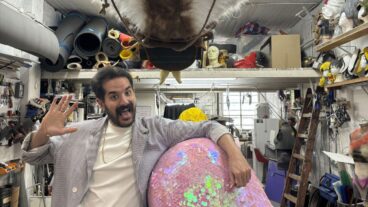Three ancient Kabbalistic amulets have been reincarnated as plush toys by Israeli artist and sculptor, Ken Goldman. The Kabbalah dolls represent the three angels sworn to protect children.The atmosphere in front of the FAO Schwarz flagship toy store in New York was tense. No one spoke. It was September 14, 2006, and artist and sculptor Ken Goldman had flown to the famous store from Israel to compete in the annual toy audition. Carrying the prototypes of his three new Kabbala dolls – Blue Sansoni, Orange Samonglif and Green Sanoi – Goldman took his place in line with crazed toy inventors from around the world.
“Everyone was outside pacing up and down, nervously watching the entrance and glancing at their watches to see how much time other people were getting,” says Goldman, who as a first-time attendee knew little about the process of making toys. While most of the inventors were granted three minutes or less, Goldman had over 30 minutes to present his dolls and explain their connection to a ninth-century Kabbala text.
When he finished, the CEO and head buyer at FAO Schwarz told him to just leave everything with them. Now, a little over a year later, the dolls are being mass-produced and sold all over the world.
“People used to hang amulets of Sansoni, Samonglif and Sanoi over children’s beds to protect them from evil spirits,” Goldman explains. “So I took the original depictions of the amulets and turned them into three giant, colorful dolls for an exhibition in Ein Harod three years ago.”
After the exhibition, friends and family members kept requesting the dolls as gifts – especially for newborn babies. Neither a seamstress nor a toymaker, Goldman nevertheless decided to look into making a smaller prototype.
“Since I made aliya in 1985, I have been creating art and sculpting. I’ve entered many design and jewelry competitions over the years and fund all of my own work,” Goldman says. This time, the toy competition paid off.
But although the three dolls’ shapes and names are taken directly from a Kabbala text, Goldman notes that they are designed to be gifts that touch upon an old tradition of protecting children with an object; they are not meant to make a statement about the mythology surrounding Adam, Eve and Lilith, who is sometimes referred to as Adam’s first wife. In the original drawings of the amulets that Goldman used as a model, the Hebrew text above loosely translates as: “Adam and Eve: Lilith aside.”
According to Christopher Witcombe, author of Eve and the Identity of Women, Lilith appears as Adam’s first wife in midrashic literature. Lilith, a figure often celebrated today as the first feminist, abandoned Adam to go and live near the Red Sea. In the Zohar Lilith vanishes from Adam’s side after saying the unspeakable name of God. Adam then beseeches God to bring her back. Upon his request, God sends three angels – Sanoi, Sansoni and Samonglif – to Lilith. Nevertheless, despite their threats, she refuses to return, insisting instead upon harming newborn infants. She does, however, promise that no harm will come to any baby wearing an amulet with either the names or images of the three angels.
“There is a lot of conflicting press and mythology surrounding Lilith today,” says Goldman. “What interests me is reviving the protective amulet for children and turning it into something that people today can identify with. We no longer hang amulets over children’s beds, but everyone loves soft, colorful dolls.”
Of course, the current Kabbala craze makes the dolls even more appealing. “The true Kabbalists probably would not like these dolls,” he says, “because they, like the Madonna version, exist on one level in the spiritual realm and on another in the material. The question I ask is how is an amulet hanging around the neck different from a doll? These are the types of questions I am exploring today.”
But it is not unusual for Goldman’s work, which utilizes a wide range of elements – from stone to ceramics and wood to wax – to be infused with questions about religion, place and identity. Whether it’s gigantic metal spice boxes that recall the traditional kibbutz guard towers or barbecue grills engraved with wax, Goldman has designed everything from bird houses carved in the image of the country’s holiest sites to stones engraved with the days of the working week in Hebrew – what Goldman describes as an underhanded reference to the haredi practice of throwing stones at cars traveling on Shabbat.
“I have always taken a great interest in symbols and modern culture, but I don’t usually take a traditional, orthodox approach” he says, pointing to the photograph of a “homeless shouk” that he created for a Jerusalem exhibition a few years ago. In the image, a succa inside a metal-framed grocery cart symbolizes the custom to move into a succa during Succot. It also makes a pointed reference to homeless people who sometimes make homes out of grocery carts.
“It’s not exactly a traditional representation of the succa or what they were looking for, but it was accepted,” says Goldman.
In a performance piece created to celebrate the shmita year in which the fields must lie fallow, a gigantic rolling bed was wheeled through the grounds of Kibbutz Shluhot, where he lives. Goldman even encouraged people to sleep on it. In another daring piece of art, he wrapped a Torah in fine white silk, then asked a group of women to kiss it wearing bright red lipstick. With a rebellious smile, he recalls a few upset neighbors who didn’t approve when he transformed Lego into a mezuza for the doorway, but he says crossing the barriers between art and religion is part of what makes his work unique.
Wearing a pair of gray and black marble-rimmed glasses, a kippa, blue jeans and a long white shirt, Goldman looks like a laid-back, religious artist. For the last 22 years, he has juggled his commitment to the kibbutz and his career as a sculptor and designer. The son of a rabbi, he was born in Memphis and grew up along the “rabbi route,” moving from place to place and finally settling in New York. In 1985, after completing his master’s degree in industrial design at the Pratt Institute, Goldman and his wife Sandy settled here with four other couples from the Bnei Akiva youth movement.
For the first 13 years, he worked on the kibbutz fishponds, creating his art and sculpture on the side. “I have always been involved with exhibitions and competitions, but I sometimes had to do it between dishwashing and guard duty,” says Goldman.
Eleven years ago, the kibbutz founded a summer program that hosted 24 children from abroad. Last summer, the program grew to over 250 children. Goldman says that his involvement in the program has afforded him more time and flexibility to concentrate on his art and sculpture in recent years.
“I’ve never had any separation between work and travel,” he says of trips to the US that combine visiting family with the annual summer camp convention in Atlantic City. “I either love what I do or I don’t do it. And that includes trips.”
Goldman’s Kabbala dolls are available on-line for $15 each. Despite their success, Goldman says he plans to continue splitting his time between work on the kibbutz and the creation of innovative and thoughtful art.












